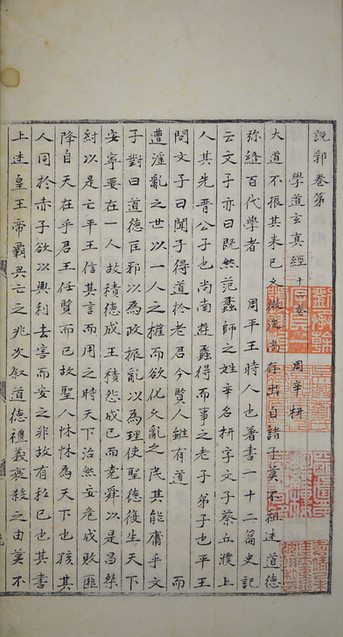叢部
Collectanea

說郛
A Collection of Random Sketches
說郛六十九卷 (元) 陶宗儀輯明沈瀚鈔本 二十四冊
烏絲欄鈔本,每半葉十四行,行二十二字。
是書書名下卷第後不書數字,饒宗頤教授曾詳論此鈔本之價值,謂是書原未成書,而最接近原書面目者或為此本, 堪稱 「人間瓌寶」。沈瀚,字原約,吳江人,明嘉靖十四年進士。《說郛》出現於元末明初,由陶宗儀 (1329-約1412) 所輯錄。陶宗儀,字九成,號南村,浙江黃岩人。除編輯是書外,尚編有《輟耕錄》三十卷。《說郛》最初以鈔本形式流傳,版本多而複雜,到崇禎年間才由杭州宛委山堂雕版付印。《說郛》收有頗多獨家史料,向為研究元末明初的學者所關注。晚近學者據其中所收之史料與現存各種《說郛》鈔本作比較,推斷這個成於嘉靖年間的鈔本內容與原書仍有距離。然而這個紙張與印章均來自沈翰的鈔本,仍有其不可或缺的地位。至少抄錄這版本的人,是希望恢復《說郛》的原貌,因此抄錄時並沒有編入卷次。是書由沈瀚的手依次轉入黃姬水 (1509-1574)、陸樵、陸雲祥 (1627年舉人)、盧址 (1725-1794) 抱經樓及劉承幹嘉業堂手中。鈐印有「嘉靖乙未進士夷齋沈瀚私印」、「四明盧氏抱經樓藏書印」、「吳興劉氏嘉業堂藏書印」 及「劉承幹字貞一號翰怡」。
Shuofu (A Collection of Random Sketches), by Tao Zongyi (Yuan), transcribed by Shen Han (Ming), 24 volumes, Ming manuscript.
The Shuofu is a collection of short stories and tales of strange and supernatural events compiled by Tao Zongyi, a Yuan dynasty scholar. This manuscript was transcribed by Shen Han, who was awarded the jinshi degree in 1535. Initially the Shuofu was circulated by means of transcribed copies, resulting in the availability of many different versions. It was not printed until the early 17th century. Over the years this work has drawn much attention from scholars studying the late Yuan and early Ming.
Professor Jao Tsung-I once discussed the value of this manuscript in great detail, referring to it as a ‘world treasure’. He commented that this manuscript was produced before the book was printed, and should be the version that is closest to the original.



文瀾閣本
A Siku Quanshu manuscript from the Wenlan Chamber
文源閣本
A Siku Quanshu manuscript from the Wenyuan Chamber
文宗閣或文匯閣寫本
A Siku Quanshu manuscript from either the Wenzong or Wenhuì Chamber
《四庫全書》寫本
公是集 十卷 (宋) 劉敞 文源閣寫本 六冊
欽定南巡盛典 一百二十卷 (清) 高晉等纂輯 文瀾閣寫本 存四冊
御定全唐詩 九百卷 (清) 彭定求等編 文宗閣或文匯閣寫本 存一冊
四庫全書館開設於乾隆三十八年(1733),歷時十四年而完成了《四庫全書》。其後陸續抄成六部,分別藏於北四閣 (文淵、文源、文津、文溯) 及南三閣 (文瀾、文宗、文匯) 。馮平山圖書館所藏四庫全書寫本三種,分別來自文源閣、文瀾閣、文宗閣或文匯閣。文源閣位於北京圓明園,書上鈐有 「文源閣寶」、 「古希天子」,開本較南三閣寫本為大。文源閣《四庫全書》毀於八國聯軍之役,能流傳下來的,十分稀少。咸豐三年(1853)南三閣的鎮江文宗閣及揚州文匯閣相繼毀於太平天國之役,杭州文瀾閣於咸豐十一年(1861)被太平軍攻佔時倒塌,後於光緒六年 (1880)重建,所藏之《四庫全書》經三次補抄才保存至今。南三閣寫本版式相若,鈐印相同,除《欽定南巡盛典》可判定文瀾閣舊物外,《御定全唐詩》經與浙江圖書館核對後,發現該館藏文瀾閣寫本,故可推斷此可能為文宗閣或文匯閣的倖存者。馮平山圖書館能庋藏南北七閣中之三閣舊藏,殊為難得。
Siku Quanshu (Complete Library of the Four Treasuries) manuscripts
Gongshi ji (Collected Works of Liu Chang), by Liu Chang (Song), 6 volumes, Wenyuan Chamber (Old Summer Palace, Beijing) manuscript.
Qinding Nanxun Shengdian (Imperial Account of the Southern Tours), by Gao Jin, et al. (Qing), 4 volumes, Wenlan Chamber (Gushan Island, West Lake, Hangzhou) manuscript.
Yuding Quantangshi (Complete Tang Poems Commissioned by the Emperor), by Peng Dingqiu, et al. (Qing), 1 volume, Wenzong Chamber (Jinshan Temple, Zhenjiang) or Wenhuì Chamber (Daguan Garden, Yangzhou) manuscript.
Compilation of the Siku Quanshu (Complete Library of the Four Treasuries) begun in 1773. It took fourteen years to complete the project. Seven copies of the Siku Quanshu were made, with four copies for the emperor in specially constructed libraries in the north (located in the Forbidden City, Old Summer Palace, Shenyang and Chengde) and three copies for the public in Siku Quanshu libraries in the south (located in Hangzhou, Zhenjiang and Yangzhou). Due to wars and civil unrest, copies housed in the Old Summer Palace, Zhenjiang and Yangzhou were destroyed, and those housed in Hangzhou were partially destroyed. The Siku Quanshu manuscripts collected by the Fung Ping Shan Library, including copies from libraries in the north and south, are extremely rare.


